Reduced trace gas oxidizers as a response to organic carbon ... - Nature.com
Abstract
Atmospheric trace gases, such as H2 and CO, are important energy sources for microbial growth and maintenance in various ecosystems, especially in arid deserts with little organic substrate. Nonetheless, the impact of soil organic C availability on microbial trace gas oxidation and the underlying mechanisms are unclear at the community level. This study investigated the energy and life-history strategies of soil microbiomes along an organic C gradient inside and out of Hedysarum scoparium islands dispersed in the Mu Us Desert, China. Metagenomic analysis showed that with increasing organic C availability from bare areas into "fertile islands", the abundance of trace gas oxidizers (TGOs) decreased, but that of trace gas nonoxidizers (TGNOs) increased. The variation in their abundance was more related to labile/soluble organic C levels than to stable/insoluble organic C levels. The consumption rates of H2 and CO confirmed that organic C addition, especially soluble organic C addition, inhibited microbial trace gas oxidation. Moreover, microorganisms with distinct energy-acquiring strategies showed different life-history traits. The TGOs had lower 16 S rRNA operon copy numbers, lower predicted maximum growth rates and higher proportions of labile C degradation genes, implying the prevalence of oligotrophs. In contrast, copiotrophs were prevalent in the TGNOs. These results revealed a mechanism for the microbial community to adapt to the highly heterogeneous distribution of C resources by adjusting the abundances of taxa with distinct energy and life-history strategies, which would further affect trace gas consumption and C turnover in desert ecosystems.
This is a preview of subscription content, access via your institution
Access options
Subscribe to this journal
We are sorry, but there is no personal subscription option available for your country.
Rent or buy this article
Get just this article for as long as you need it
$39.95
Prices may be subject to local taxes which are calculated during checkout
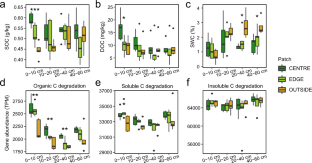
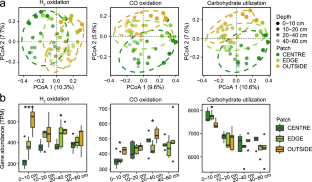
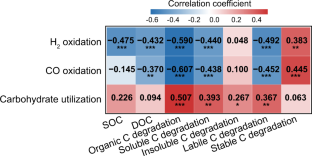

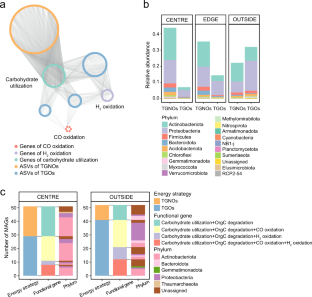
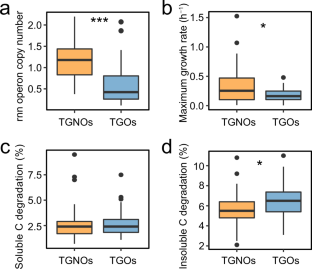
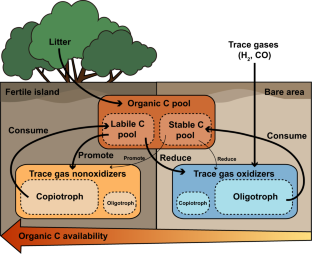
Data availability
The high-throughput sequencing dataset and metagenomic sequencing dataset are available in the National Center for Biotechnology Information (NCBI) Sequence Read Archive (SRA) database with accession number PRJNA859390 and PRJNA909948.
References
Makhalanyane TP, Valverde A, Gunnigle E, Frossard A, Ramond JB, Cowan DA. Microbial ecology of hot desert edaphic systems. FEMS Microbiol Rev. 2015;39:203–21.
Pointing SB, Belnap J. Microbial colonization and controls in dryland systems. Nat Rev Microbiol. 2012;10:551–62.
Ji M, Greening C, Vanwonterghem I, Carere CR, Bay SK, Steen JA, et al. Atmospheric trace gases support primary production in Antarctic desert surface soil. Nature 2017;552:400–3.
Leung PM, Bay SK, Meier DV, Chiri E, Cowan DA, Gillor O, et al. Energetic basis of microbial growth and persistence in desert ecosystems. mSystems 2020;5:e00495–19.
Cordero PRF, Bayly K, Man Leung P, Huang C, Islam ZF, Schittenhelm RB, et al. Atmospheric carbon monoxide oxidation is a widespread mechanism supporting microbial survival. ISME J. 2019;13:2868–81.
Greening C, Carere CR, Rushton-Green R, Harold LK, Hards K, Taylor MC, et al. Persistence of the dominant soil phylum Acidobacteria by trace gas scavenging. Proc Natl Acad Sci USA. 2015;112:10497–502.
Pinske C, McDowall JS, Sargent F, Sawers RG. Analysis of hydrogenase 1 levels reveals an intimate link between carbon and hydrogen metabolism in Escherichia coli K-12. Microbiology 2012;158:856–68.
Bay SK, Waite DW, Dong X, Gillor O, Chown SL, Hugenholtz P, et al. Chemosynthetic and photosynthetic bacteria contribute differentially to primary production across a steep desert aridity gradient. ISME J. 2021;15:3339–56.
Bay SK, Dong X, Bradley JA, Leung PM, Grinter R, Jirapanjawat T, et al. Trace gas oxidizers are widespread and active members of soil microbial communities. Nat Microbiol. 2021;6:246–56.
Schmidt MWI, Torn MS, Abiven S, Dittmar T, Guggenberger G, Janssens IA, et al. Persistence of soil organic matter as an ecosystem property. Nature. 2011;478:49–56.
Marschner B, Kalbitz K. Controls of bioavailability and biodegradability of dissolved organic matter in soils. Geoderma. 2003;113:211–35.
Fanin N, Fromin N, Buatois B, Hättenschwiler S. An experimental test of the hypothesis of non-homeostatic consumer stoichiometry in a plant litter–microbe system. Ecol Lett. 2013;16:764–72.
Fierer N, Bradford MA, Jackson RB. Toward an ecological classification of soil bacteria. Ecology. 2007;88:1354–64.
Koch AL. Oligotrophs versus copiotrophs. BioEssays. 2001;23:657–61.
Trivedi P, Anderson IC, Singh BK. Microbial modulators of soil carbon storage: integrating genomic and metabolic knowledge for global prediction. Trends Microbiol. 2013;21:641–51.
Greening C, Grinter R. Microbial oxidation of atmospheric trace gases. Nat Rev Microbiol. 2022;20:513–28.
Ochoa-Hueso R, Eldridge DJ, Delgado-Baquerizo M, Soliveres S, Bowker MA, Gross N, et al. Soil fungal abundance and plant functional traits drive fertile island formation in global drylands. J Ecol. 2018;106:242–53.
Schlesinger WH, Raikes JA, Hartley AE, Cross AE. On the spatial pattern of soil nutrients in desert ecosystems. Ecology 1996;77:1270.
Chen YJ, Neilson JW, Kushwaha P, Maier RM, Barberán A. Life-history strategies of soil microbial communities in an arid ecosystem. ISME J. 2021;15:649–57.
Ding J, Eldridge DJ. The fertile island effect varies with aridity and plant patch type across an extensive continental gradient. Plant Soil. 2021;459:173–83.
Miao C, Bai Y, Zhang YQ, She W, Liu L, Qiao Y, et al. Interspecific interactions alter plant functional strategies in a revegetated shrub-dominated community in the Mu Us Desert. Ann Bot. 2022;130:149–58.
Callahan BJ, McMurdie PJ, Rosen MJ, Han AW, Johnson AJA, Holmes SP. DADA2: high–resolution sample inference from Illumina amplicon data. Nat Methods. 2016;13:581–3.
Bolger AM, Lohse M, Usadel B. Trimmomatic: a flexible trimmer for Illumina sequence data. Bioinformatics. 2014;30:2114–20.
Li D, Liu CM, Luo R, Sadakane K, Lam TW. MEGAHIT: an ultra-fast single-node solution for large and complex metagenomics assembly via succinct de Bruijn graph. Bioinformatics. 2015;31:1674–6.
Steinegger M, Söding J. MMseqs2 enables sensitive protein sequence searching for the analysis of massive data sets. Nat Biotechnol. 2017;35:1026–8.
Zhu WH, Lomsadze A, Borodovsky M. Ab initio gene identification in metagenomic sequences. Nucleic Acids Res. 2010;38:e132.
Patro R, Duggal G, Love MI, Irizarry RA, Kingsford C. Salmon provides fast and bias-aware quantification of transcript expression. Nat Methods. 2017;14:417–9.
Cantarel BL, Coutinho PM, Rancurel C, Bernard T, Lombard V, Henrissat B. The Carbohydrate-Active EnZymes database (CAZy): an expert resource for glycogenomics. Nucleic Acids Res. 2009;37:D233–D238.
Dai ZM, Zang HD, Chen J, Fu YY, Wang XH, Liu HT, et al. Metagenomic insights into soil microbial communities involved in carbon cycling along an elevation climosequences. Environ Microbiol. 2021;23:4631–45.
Donhauser J, Qi WH, Bergk-Pinto B, Frey B. High temperatures enhance the microbial genetic potential to recycle C and N from necromass in high-mountain soils. Glob Change Biol. 2021;27:1365–86.
Liu FT, Kou D, Chen YL, Xue K, Ernakovich JG, Chen LY, et al. Altered microbial structure and function after thermokarst formation. Glob Change Biol. 2021;27:823–35.
Sun YF, Liu Z, Zhang YQ, Lai ZG, She WW, Bai YX, et al. Microbial communities and their genetic repertoire mediate the decomposition of soil organic carbon pools in revegetation shrublands in a desert in northern China. Eur J Soil Sci. 2020;71:93–105.
Søndergaard D, Pedersen CNS, Greening C. HydDB: A web tool for hydrogenase classification and analysis. Sci Rep. 2016;6:34212.
Uritskiy GV, DiRuggiero J, Taylor J. MetaWRAP-a flexible pipeline for genome-resolved metagenomic data analysis. Microbiome. 2018;6:158.
Parks DH, Imelfort M, Skennerton CT, Hugenholtz P, Tyson GW. CheckM: assessing the quality of microbial genomes recovered from isolates, single cells, and metagenomes. Genome Res. 2015;25:1043–55.
Bowers RM, Kyrpides NC, Stepanauskas R, Harmon-Smith M, Doud D, Reddy TBK, et al. Minimum information about a single amplified genome (MISAG) and a metagenome-assembled genome (MIMAG) of bacteria and archaea. Nat Biotechnol. 2017;35:725–31.
Jordaan K, Lappan R, Dong XY, Aitkenhead LJ, Bay SK, Chiri E, et al. Hydrogen-oxidizing bacteria are abundant in desert soils and strongly stimulated by hydration. mSystems. 2020;5:e01131–20.
Liu YR, Delgado-Baquerizo M, Bi L, Zhu J, He JZ. Consistent responses of soil microbial taxonomic and functional attributes to mercury pollution across China. Microbiome. 2018;6:183.
Roller BRK, Stoddard SF, Schmidt TM. Exploiting rRNA operon copy number to investigate bacterial reproductive strategies. Nat Microbiol. 2016;1:16160.
Botzman M, Margalit H. Variation in global codon usage bias among prokaryotic organisms is associated with their lifestyles. Genome Biol. 2011;12:R109.
Vieira-Silva S, Rocha EPC. The systemic imprint of growth and its uses in ecological (meta) genomics. PLoS Genet. 2010;6:e1000808.
Stoddard SF, Smith BJ, Hein R, Roller BRK, Schmidt TM. rrnDB: improved tools for interpreting rRNA gene abundance in bacteria and archaea and a new foundation for future development. Nucleic Acids Res. 2015;43:D593–D598.
Li H, Yang S, Semenov MV, Yao F, Ye J, Bu RC, et al. Temperature sensitivity of SOM decomposition is linked with a K-selected microbial community. Glob Change Biol. 2021;27:2763–79.
Zhu YC, Wang LJ, Zhao XY, Lian J, Zhang ZH. Accumulation and potential sources of heavy metals in soils of the Hetao area, Inner Mongolia, China. Pedosphere. 2020;30:244–52.
Jones DL, Willett VB. Experimental evaluation of methods to quantify dissolved organic nitrogen (DON) and dissolved organic carbon (DOC) in soil. Soil Biol Biochem. 2006;38:991–9.
Ghani A, Dexter M, Perrott KW. Hot-water extractable carbon in soils: a sensitive measurement for determining impacts of fertilisation, grazing and cultivation. Soil Biol Biochem. 2003;35:1231–43.
Lappan R, Shelley G, Islam ZF, Leung PM, Lockwood S, Nauer PA, et al. Molecular hydrogen is an overlooked energy source for marine bacteria. bioRxiv. 2022. https://doi.org/10.1101/2022.01.29.478295.
Lauro FM, McDougald D, Thomas T, Williams TJ, Egan S, Rice S, et al. The genomic basis of trophic strategy in marine bacteria. Proc Natl Acad Sci USA. 2009;106:15527–33.
Roller BRK, Schmidt TM. The physiology and ecological implications of efficient growth. ISME J. 2015;9:1481–7.
Berney M, Greening C, Conrad R, Jacobs WR, Cook GM. An obligately aerobic soil bacterium activates fermentative hydrogen production to survive reductive stress during hypoxia. Proc Natl Acad Sci USA. 2014;111:11479–84.
Moxley J, Smith K. Carbon monoxide production and emission by some Scottis...
Comments
Post a Comment